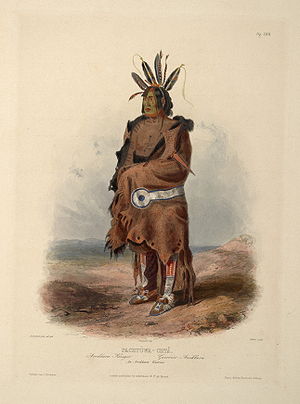Arikara War
| Arikara War | |||||||
|---|---|---|---|---|---|---|---|
| Part of the American Indian Wars | |||||||
 An Arikara warrior, by artist Karl Bodmer |
|||||||
|
|||||||
| Belligerents | |||||||
| United States Sioux |
Arikara | ||||||
| Commanders and leaders | |||||||
|
William Ashley Joshua Pilcher |
Chief Grey Eye Chief Little Soldier |
||||||
| Units involved | |||||||
Missouri Legion
|
Arikara
|
||||||
| Casualties and losses | |||||||
| 12 members of Ashley's company killed | Likely more than 10 warriors and villagers, among them chief Grey Eye. | ||||||
Missouri Legion
Arikara
The Arikara War was an armed conflict between the United States, their allies from the Sioux (or Dakota) tribe and Arikara Native Americans that took place in the summer of 1823, along the Missouri River in present-day South Dakota. It was the first Indian war west of the Missouri fought by the U.S. Army and its only conflict ever with the Arikara. The war came as a respond to an Arikara attack on trappers, called "the worst disaster in the history of the Western fur trade".
When Lewis and Clark reached Arikara settlements in 1804, the inhabitants did not show hostility to the expedition. In 1806, during a trip to the United States capital, an Arikara leader died, and many Arikara believed that Americans were involved in his death. Later, as a result of the growing activity of fur trading companies, contact between Arikara and white merchants became more frequent, and skirmishes eventually followed. In the start of 1823, the Arikaras "attacked the Missouri Fur Company's Fort Recovery [a trading post for the Sioux] and killed two traders".
The Sioux, both Yankton and Yanktonai east of the Missouri and Lakota on the west side, had for long been at war with the Arikara, interrupted by short truces on Sioux terms. The Arikaras in question were living in a double village on the west shore of the Missouri, six or seven miles upstream from the mouth of Grand River. A small creek separated the two fortified villages of earth lodges, each with a heavy frame of wood.
On 2 June 1823, Arikara warriors assaulted trappers working for General William Henry Ashley's Rocky Mountain Fur Company on the Missouri River, killing about 15 people. This attack is depicted in the 2015 film The Revenant. The surviving trappers retreated down the river and hid in shelters, where they stayed for more than a month. The United States responded with a combined force of 230 soldiers of the 6th Infantry, 750 Sioux allies, and 50 trappers and other company employees under the command of Lieutenant Colonel Henry Leavenworth, Fort Atkinson, present-day Nebraska. "The forces thus organized, including regular troops, mountaineers, voyageurs and Indians, were styled the Missouri Legion". The 750 warriors were part Yankton and Yanktonai Sioux, part western Sioux from the Brule, the Blackfeet and the Hunkpapa divisions. The Lakotas "... appeared anxious to join us". The Indian force received promises of Arikara horses and spoils, and with the enemy's villages fallen new ranges would open for the Sioux.
...
Wikipedia
